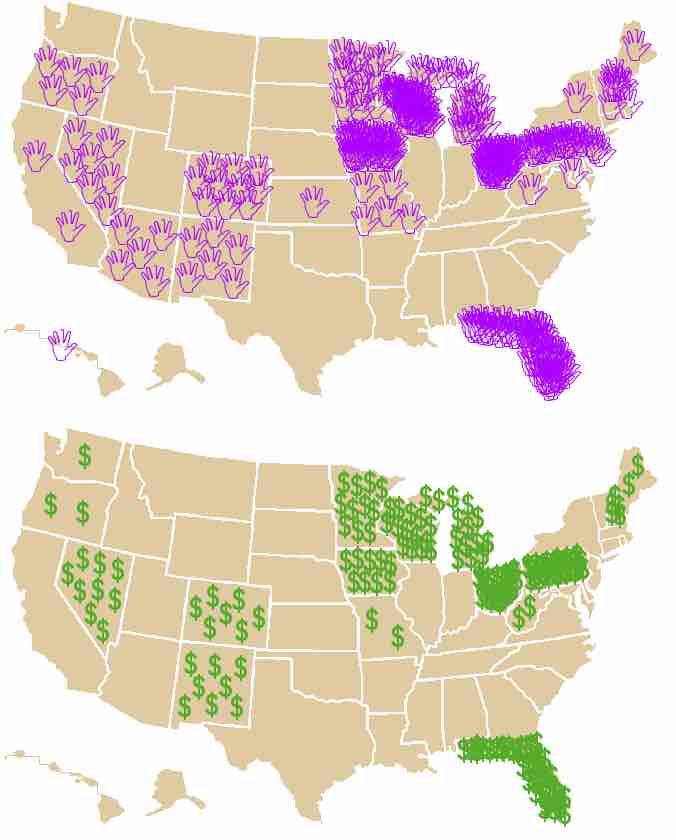Indirect Election
The Electoral College is an example of indirect election, when a democratic government is voted into power by a representative vote, rather than by the entirety of the electorate. The Electoral College consists of 538 electors who officially elect the President and Vice President of the United States. The number of electors equals the total voting membership of the United States Congress, with one elector for each of the current 435 Representatives and 100 Senators. The Electoral College also includes three electors from the District of Columbia, which were approved in the Twenty-third Amendment to the Constitution, in 1961. That results in 538 total electors.
Allocation of Electors
Each state is awarded the same number of electoral votes as the number of its Representatives, plus two votes to match its Senatorial count. Since the most populous states have the most seats in the House of Representatives, they also have the most electors. The six states with the most electors are California (55), Texas (38), New York (29), Florida (29), Illinois (20), and Pennsylvania (20). The seven smallest states by population in the Electoral College (Alaska, Delaware, Montana, North Dakota, South Dakota, Vermont, and Wyoming) have three electors. Each state's number of Representatives is determined every 10 years by the US Census, thus determining the number of electoral votes for each state.

Electoral College (2008)
In the presidential general election, the winner is determined based on who receives the greatest number of votes in the Electoral College system.
Thus, though many people do not realize it, Presidential and Vice-Presidential elections are determined not by a popular vote. Although ballots list the names of the presidential candidates, voters within the 50 states and Washington, D.C. actually choose electors for their state when they vote for President and Vice President. These presidential electors in turn cast electoral votes for those two offices. Even though the aggregate national popular vote is calculated by state officials and media organizations, the national popular vote is not the basis for electing a President or Vice President.
A faithless elector is a member of the United States Electoral College who, for whatever reason, does not vote for the presidential or vice presidential candidate for whom he or she had pledged to vote. They may vote for another candidate or not vote at all. Faithless electors are pledged electors and thus different from unpledged electors. Although there have been 157 cases of faithlessness, faithless electors have not changed the outcome of any presidential election to date.
Exceptions
Voters in each state and the District of Columbia cast ballots selecting electors pledged to presidential and vice presidential candidates. In nearly all states, electors are awarded to the candidate who wins the most votes in that state on a winner-take-all basis. This means that if Candidate A wins 51% of the popular vote in a given state and Candidate B wins 49%, Candidate A would take all of the Electoral College votes for this state. Only Maine and Nebraska award Electoral College votes on a proportional basis. Although electors are not required by federal law to honor a pledge, in the overwhelming majority of cases they vote for the candidate to whom they are pledged.
Evaluations of the Electoral System
Critics argue that the Electoral College is inherently undemocratic and gives swing states disproportionate influence in electing the President and Vice President. Swing states are those that are up for grabs in any given election; historically, they have swung back and forth between Democrats and Republicans. However, many of them have large numbers of Electoral College votes, meaning that candidates play to voters in swing states more than in other states. Further, some maintain that it is a doctrinal problem that presidential elections in the United States are not decided by popular vote.

Campaign Attention to Swing States (2004)
These maps show the amount of attention the Bush and Kerry campaigns (considered together) gave to each state during the final five weeks of the 2004 election: At the top, each waving hand represents a visit from a presidential or vice-presidential candidate during the final five weeks of the election. (Candidates' visits to their own home states are not counted. ) At the bottom, each dollar sign represents one million dollars spent on TV advertising by the campaigns during the same time period. This shows the influence of the Electoral College on the prominence of swing states, those with small populations but large Electoral College votes.
Proponents argue that the Electoral College is an important, distinguishing feature of federalism in the United States and that it protects the rights of smaller states. Many proponents of the Electoral College see its negative effect on third parties as a good thing. They argue that the two party system has provided stability through its ability to change during times of rapid political and cultural change. They believe it protects the most powerful office in the country from control by what these proponents view as regional minorities until they can moderate their views to win national election.